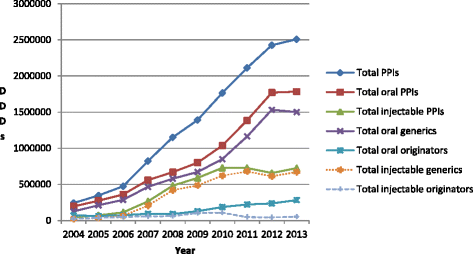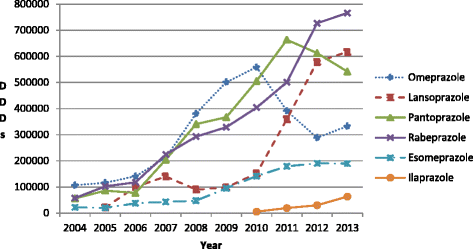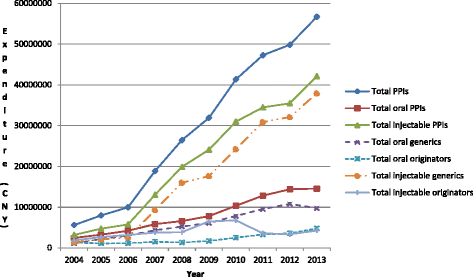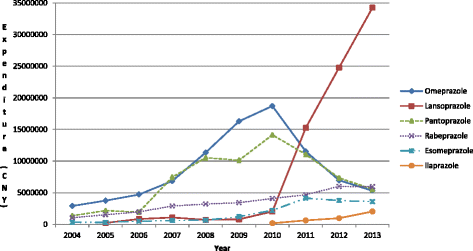Prescribing efficiency of proton pump inhibitors in China: influence and future directions
- PMID: 25609265
- PMCID: PMC4308879
- DOI: 10.1186/s12913-014-0638-6
Prescribing efficiency of proton pump inhibitors in China: influence and future directions
Abstract
Background: Pharmaceutical expenditure is currently rising by 16% per annum in China, greater in recent years. Initiatives to moderate growth include drug pricing regulations, essential medicine lists and encouraging generic prescribing. These are principally concentrated in hospitals, which currently account for over 80% of total pharmaceutical expenditure. However, no monitoring of prescribing and perverse incentives encouraging physicians and hospitals to profit from drug procurement encourages irrational prescribing. This includes greater utilisation of originators versus generics as well as injectables when cheaper oral equivalents are available. The objective of the paper is to assess changes in proton pump inhibitor (PPI) utilisation and expenditure in China as more generics become available including injectables.
Methods: Observational retrospective study of PPI utilisation and procured expenditure between 2004 and 2013 in the largest teaching hospital in Chongqing District as representative of China.
Results: Appreciable increase in PPI utilisation during the study period rising 10.4 fold, with utilisation of generics rising faster than originators. Oral generics reached 84% of total oral preparations in 2013 (defined daily dose basis), with generic injectables 93% of total injectables by 2013. Injectables accounted for 42% of total PPI utilisations in 2008 and 2009 before falling to below 30%. Procured prices for oral preparations reduced over time (-34%). Generic oral omeprazole in 2010 was 87% below 2004 originator prices, mirroring reductions seen in Western Europe. Injectable prices also decreased over time (-19%). However, injectables typically 4.3 to 6.8 fold more expensive than equivalent orals - highest for injectable lansoprazole at 13.4 to 18.0 fold. High utilisation of more expensive oral PPIs as well as injectables meant that PPI expenditure increased 10.1 fold during the study period. Lower use of injectables, and only oral generic omeprazole, would result in accumulated savings of CNY249.65 million, reducing total accumulated expenditure by 84%.
Conclusions: Encouraging to see high utilisation of generic PPIs and low prices for oral generics. However, considerable opportunities to enhance prescribing efficiency through greater use of oral generic omeprazole.
Figures




Similar articles
-
Changes in proton pump inhibitor prescribing trend over the past decade and pharmacists' effect on prescribing practice at a tertiary hospital.BMC Health Serv Res. 2018 Jul 11;18(1):537. doi: 10.1186/s12913-018-3358-5. BMC Health Serv Res. 2018. PMID: 29996830 Free PMC article.
-
Initiatives to enhance the quality and efficiency of statin and PPI prescribing in the UK: impact and implications.Expert Rev Pharmacoecon Outcomes Res. 2010 Feb;10(1):73-85. doi: 10.1586/erp.09.73. Expert Rev Pharmacoecon Outcomes Res. 2010. PMID: 20121565
-
Review of ongoing initiatives to improve prescribing efficiency in China; angiotensin receptor blockers as a case history.Expert Rev Pharmacoecon Outcomes Res. 2015 Feb;15(1):157-69. doi: 10.1586/14737167.2015.963557. Epub 2014 Oct 28. Expert Rev Pharmacoecon Outcomes Res. 2015. PMID: 25348709
-
Policies to enhance the efficiency of prescribing in the Spanish Catalan region: impact and future direction.Expert Rev Pharmacoecon Outcomes Res. 2009 Dec;9(6):569-81. doi: 10.1586/erp.09.58. Expert Rev Pharmacoecon Outcomes Res. 2009. PMID: 19941434 Review.
-
Reforms and initiatives in Scotland in recent years to encourage the prescribing of generic drugs, their influence and implications for other countries.Expert Rev Pharmacoecon Outcomes Res. 2013 Aug;13(4):469-82. doi: 10.1586/14737167.2013.820956. Expert Rev Pharmacoecon Outcomes Res. 2013. PMID: 23977975 Review.
Cited by
-
Changes in proton pump inhibitor prescribing trend over the past decade and pharmacists' effect on prescribing practice at a tertiary hospital.BMC Health Serv Res. 2018 Jul 11;18(1):537. doi: 10.1186/s12913-018-3358-5. BMC Health Serv Res. 2018. PMID: 29996830 Free PMC article.
-
Consumption of medicines used for gastric acid-related disorders in Australia and South Korea: a cross-country comparison.Eur J Clin Pharmacol. 2020 Apr;76(4):547-555. doi: 10.1007/s00228-019-02798-8. Epub 2019 Dec 10. Eur J Clin Pharmacol. 2020. PMID: 31822956
-
Long-term use of proton-pump inhibitors: whole-of-population patterns in Australia 2013-2016.Therap Adv Gastroenterol. 2020 Mar 19;13:1756284820913743. doi: 10.1177/1756284820913743. eCollection 2020. Therap Adv Gastroenterol. 2020. PMID: 32218806 Free PMC article.
-
Continuous improvement on the rationality of prophylactic injectable PPIs usage by a clinical pharmacist-led guidance team at a Chinese tertiary teaching hospital.J Int Med Res. 2020 Oct;48(10):300060520954729. doi: 10.1177/0300060520954729. J Int Med Res. 2020. PMID: 33045898 Free PMC article.
-
Disinvestment and Value-Based Purchasing Strategies for Pharmaceuticals: An International Review.Pharmacoeconomics. 2015 Sep;33(9):905-24. doi: 10.1007/s40273-015-0293-8. Pharmacoeconomics. 2015. PMID: 26048353 Review.
References
-
- OECD. OECD, Health at a Glance 2011: OECD Indicators. Available at URL: http://www.oecd.org/els/health-systems/49105858.pdf
-
- Vogler S, Zimmermann N, Habl C. Understanding the components of pharmaceutical expenditure - overview of pharmaceutical policies influencing expenditure across European countries. GaBi J. 2013;2(3):178–187. doi: 10.5639/gabij.2013.0204.051. - DOI
Publication types
MeSH terms
Substances
LinkOut - more resources
Full Text Sources
Other Literature Sources

